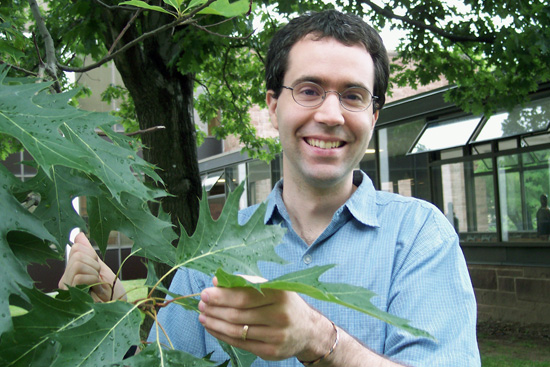Faculty Finds Strongest Evidence Yet of Link Between CO2 and Global Temperature Change
 |
| A study by Dana Royer, assistant professor of earth and environmental sciences, has established a calculable relationship between increases in CO2 and global surface temperatures. |
| Posted 04/02/07 |
| The connection between CO2 concentrations and increased global temperatures just gained a significant amount of evidence – about 420 million years worth of evidence, to be specific.
In a paper published in the March 29 issue of Nature, Dana Royer, assistant professor of earth and environmental sciences, and two colleagues from Yale University have used nearly 500 data points to create the most comprehensive model of the relationship between CO 2 and temperature to date. The findings indicate that over the last 420 million years increases in CO2 in the atmosphere have had a direct and calculable relationship to increases in global surface temperatures.Royer is the studys primary investigator; his co-authors on the paper are Robert Berner and Jeffrey Park who are both faculty at the Department of Geology and Geophysics at Yale University. The study provides the strongest and most conclusive evidence to date that, in the history of the Earth, rises in atmospheric CO 2 concentrations are directly linked to increases in global surface temperatures.This link has been established by previous studies, but the most expansive of these only went back about 15,000 years, Royer says. Thats barely a blink of an eye in terms of the life of the planet. Our study went back much further in time. It was intriguing that much of what we found was consistent with these other studies. Specifically, what Royer and his co-investigators found was that every doubling of atmospheric CO 2 concentrations resulted in an approximately 3° C (approx 5 ° F) increase in global surface temperature. This ratio is consistent with shorter-term models and surveys.Of course, identifying accurate data points for atmospheric CO 2 are what make studies such as these difficult. Before approximately 50 years ago, there were no atmospheric CO2 measurements made directly by human beings. However, scientists have been able to use a variety of methods that rely on studies of soil, sediments, sea beds, and even fossils.One method involves analyzing the stomata of certain kinds of fossilized plants, Royer says. When the CO 2 concentrations are higher, plants will have fewer pores for gas exchange. When it is lower, these plants will have more pores. This information can be combined with what we know about the temperature and other environmental factors from that period in a particular kind of modeling. Royer and his fellow researchers were able to draw together the data generated from a variety of methods to create their study. |
| By David Pesci, director of Media Relations |

